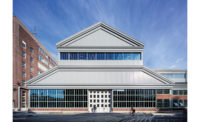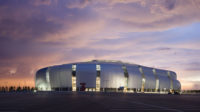Scarsdale, New York
While the symbolic program for a synagogue is distinct, as an iconic structure it lacks the identifiable architectural typology of, say, a Gothic-style cathedral or a domed mosque. Since the first Diaspora of the Jews in the 7th century B.C., Jewish synagogues have responded to the particulars of places and living situations of migrating congregants, as Henry and Daniel Stolzman note in Synagogue Architecture in America, Faith, Spirit, and Identity (2004).
For that reason, architects have often been free to experiment with this building type, arriving at contemporaneous solutions that achieve a sense of identity within a particular context. Yet when the New York firm of Rogers Marvel Architects won the commission to execute the master plan and to design a new sanctuary for the Westchester Reform Temple campus in Scarsdale, New York, it was faced with a hodgepodge of religious structures.
The amorphous agglomeration resulted from growth and modification by previous architects, beginning with Marcel Breuer, who designed a sanctuary in 1959, followed by Percival Goodman’s expansion in 1964, plus a separate structure, the Center for Jewish Life, which Peter Gisolfi added to a historic house in 1998. What’s more, the complex’s 9-acre site occupies a residential section of this New York City suburb, whose inhabitants were very touchy about institutional growth.
The principals, Rob Rogers, FAIA, and Jonathan Marvel, AIA, had not designed a synagogue before. They got on the Request for Qualifications list through the most reliable of devices, word of mouth, stemming from a house they designed some years back in Wyoming. Moreover, they are not Jewish. But Rabbi Richard Jacobs and the congregation found the architects took the time to listen and did not seem to be wedded to preconceived ideas about the architecture: “We wanted a place of meaning that embodied core values of the community,” says Jacobs.
Program
The congregation had outgrown the old sanctuary, the Breuer-designed space, which had been subsumed by Goodman’s expansion. In its new master plan, Rogers Marvel called for converting it into a 14,000-square-foot religious school and study center, now under construction.
In addition to the renovated spaces, there would be a new, 17,000-square-foot structure for the sanctuary that could expand from 400 seats to 600 for special occasions and 1,250 during the High Holy Days. During most of the year, this extra space would function as a social hall, with a kitchen attached.
While the congregation needed flexibility in such accommodations, it didn’t want to sacrifice the feeling of spiritual contemplation for those sitting in the add-on spaces during the special holidays or celebrations. Balance was key in inspiring the sense of intimacy and community, without losing the impression of grandeur.
In terms of the effect of the entire 50,000-square-foot complex on the residential neighborhood, the architects needed to improve pedestrian circulation and parking for the synagogue while providing landscaped areas that would make the campus more cohesive, yet less obtrusive, in its surroundings.
Solution
Rogers and Marvel designed the new building to push out from the south side of the existing structures so that the sanctuary faces east, as is traditionally prescribed. The hall is wider than it is deep so the congregants, as project architect Alissa Bucher explains, enter on a diagonal axis from the lobby without having to approach it from the social spaces at the rear. Inside the sanctuary itself, the architects placed the ark containing the Torahs and the bimah (the elevated platform where the service is performed) on axis with the diagonal entrance.
Steel trusses with 90-foot spans form seven bays in the main hall. These seven “bands” refer to the seven days of the week, with the final one containing the space of the bimah. When the room is opened up at the rear, a total of 12 bays appear, signifying the twelve Tribes of Israel.
An interplay of cedar and white plaster elements define the sanctuary’s walls and ceiling. Glazed vertical strips define the bays in the upper portion of the north elevation and the lower portion of the south, while skylights softly illuminate the interior during the day. The articulation of north and south walls, where the angled cedar panels are pulled out from the perimeter, acoustically enhances the space, and provides a dramatic background for inscriptions. Behind the bimah, the olive ash ark seems to float in the expansive glass-louvered walls (but is actually suspended from aluminum fins, anchored to the steel framework). The louvered glass faces east to a landscaped garden but is shielded from it by an outer wall of low-E glass panels in an aluminum curtain-wall system. In spite of the double wall, separated by a 5-foot-wide service passage, ample daylight can be admitted and bounced off the L-shaped louvers. The architects were careful to surface undersides with mirrored chrome and coat the top sides with a blue paint to reflect the colors of the garden and sky while cutting the glare into the hall.
Commentary
The sanctuary achieves a timeless, monumental quality, yet offers an intimate and comfortable ambience. A Modern aesthetic extends throughout, and the palette of handsome natural materials and colors adds to the hushed allure of the space. Since the project is not complete with regard to other parts of the temple, it is hard to say whether the ensemble as a whole will produce the coherence that the team desires. This first phase — especially the sanctuary with its distinctive architectural solution — represents an auspicious beginning.
the PeopleClient: Westchester Reform Temple
Architect:
Personnel in architect's firm who should receive special credit: Project Architect: Alissa Bucher, AIA Designers: Josh Kaplan, Chris Dameron, Gary Machicek, Lisa So, Minh Tran, Ben Regnier, Mary Ann Holiday, Elena Brescia, Haily Tweedie
Owners Representation:
Engineer(s): MEP: Collado Engineering
Consultant(S)
Acoustical: Jaffe Holden Envelope Consultant: Henshell Buccellato Special consultant: Harley Swedler
General Contractor:
Photographer(S):
CAD system, project management, or other software used: Gross square footage:
50,000 square feet (total) Total construction cost: $12 million (construction) Completion date: September 2009 (first phase)
|
the Products
Exterior cladding
Metal/glass curtainwall:
Windows
Doors
Hardware Pulls: Rockwood
Interior finishes
Cedar Wood Work:
Wood Floor:
Carpet:
Raised flooring:
Furnishings
Lighting
Downlights:
Exterior:
Controls:
Plumbing Aluminum System: TriPyramid Structures, Inc.
Ark:
Reading Table:
Memorial Wall: |











Post a comment to this article
Report Abusive Comment